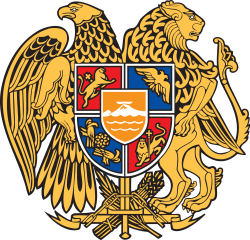Coat of arms of Armenia
Friday, September 24, 2021
The national coat of arms of Armenia was adopted on April 19, 1992, by resolution of the Armenian Supreme Council.
On June 15, 2006, the Armenian Parliament passed the law on the state coat of arms of Armenia.
It consists of an eagle and a lion supporting a shield. The coat of arms combines new and old symbols. The eagle and lion are ancient Armenian symbols dating from the first Armenian kingdoms that existed prior to Christ. These symbols are found on the Armenian Highland from times immemorial. Numerous Armenian dynasties such as Artaxiad, Arsacid, Bagratuni and Rubenid, used these symbols as their royal insignia. Like other post-Soviet republics whose symbols do not predate the October Revolution, the current emblem retained one component of the Soviet one such as the Mount Ararat on the shield. Prior to 1992, Armenia had an emblem similar to all other Soviet Republics.
Shield
The shield itself consists of many components. In the center is a depiction of the Mount Ararat with Noah's Ark sitting atop it. According to tradition, the ark is said to have finally rested on the mountain after the great flood. Ararat is considered the national symbol of Armenia and thus is of principal importance to the coat of arms. Surrounding Mount Ararat are symbols of old Armenian dynasties. In the lower left portion of the shield, there are two eagles looking at each other, symbolizing the length of the Armenian territory during the reign of the Artaxiad Dynasty that ruled from the second century B.C. to the beginning of the Christian era. In the upper left portion, there is a lion with a cross, the emblem for the Bagratuni Dynasty that ruled during the Middle Ages, between the 9th and 11th centuries. Under this dynasty, Armenia blossomed culturally, making its capital, Ani, one of the most important cultural, social and commercial centers of its time. The Bagratuni kingdom was destroyed by the Byzantine Empire's encroachment and by Seljuk conquests in the 11th century. In the upper right portion, there is a two-headed eagle, the emblem of the first dynasty to reign over Christian Armenia, the Arsacid Dynasty, which ruled from the first century to 428. Tiridates III made Armenia the first country to adopt Christianity as official religion in 301. In the lower right portion, there is a lion with a cross, the emblem of the Rubenid dynasty. This dynasty reigned in the Armenian Kingdom of Cilicia, a state that expanded and prospered during the 12th and 13th centuries, until the Mamelukes eventually conquered it in 1375.
Eagle and Lion
The eagle supports the shield on the left side of the coat of arms, while the lion on the right side. The eagle was the symbol of the Artaxiad Dynasty and later on the symbol of the Arsacid Dynasty of Armenia. It holds the Artaxiad Dynasty's branch of the shield. Whereas, the lion was the symbol of the Bagratuni Dynasty and later on the symbol of the Rubenid Dynasty. It holds the Rubenid Dynasty's branch of the shield. The eagle and the lion are a common theme for civilizations on the Armenian Highland. As such they have been represented throughout various Armenian dynasties.
Both of these animals were chosen because of their power, courage, patience, wisdom, and nobility in animal kingdom.
About the Symbol ascribed to the Arshakids in the Coat of Arms of the Republic of Armenia (Double-Headed Eagle)
Since 1920, the symbol of the two-headed eagle on the shield of the RA coat of arms has been attributed to the Arshakid dynasty. Despite the lack of direct evidence, a comparative analysis of the available pictographic, chronicle, and bas-relief materials leads us to conclude that the double-headed eagle could refer to Arshakid Armenia, with the only difference being that the symbol in the coat of arms of Armenia does not represent the Arshakid dynasty itself, but their era and fame, being a synthesis of the two-headed eagle of the Mamikonyans and the same eagle of the Armenian Church established by the Arshakids.
Five vital elements
- The sword represents the power and strength of the nation, breaking the chains of oppression.
- The broken chain represents the effort shown by the nation to gain freedom and independence.
- The wheat ears represent the hard-working nature of the Armenian people.
- The feather represents the intellectual and cultural heritage of the Armenian people (as a quill pen).
- The ribbon represents the colors of the flag of Armenia blue, the sky, orange, courage (Noah's Ark), red, 1.5 million deaths on the genocide.





